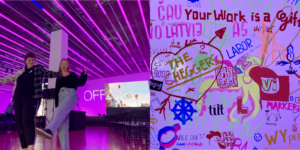Our weekend OFFF: A journey through the good, the bad, and the ugly
14 Apr 23
Last month, we were given the unique opportunity to go to OFFF Festival in Barcelona, a creative event focused on all things design, motion, and illustration. Using our personal development budgets to go on the trip, we were able to learn from some of the most innovative and inspiring thinkers in the industry.
In this article, Helena and I take you on a journey through the good, the bad, and the ugly of our weekend OFFF.
The Good:
Which, if any speaker, fed your creative brain the most, and why?
Choosing a favourite speaker isn’t easy, but both of us agree that Timothy Goodman’s talk totally blew us away. Confession: we didn’t even plan to see his talk and had no idea who he was. We just wanted to snag good seats for the talk after his. But Timothy’s talk went way beyond what we could have possibly expected, even if those expectations were pretty non-existent to begin with.
As a comforting jazz melody filled the room, played by Timothy’s accompanying band, he began with a brief introduction to who he was and the kind of work he does; a blend of beautiful typography and linework illustrations. You couldn’t help but immediately get the sense that Timothy puts his heart and soul into anything and everything he does. And he proceeded to prove that assumption right. Literally.
The rest of his talk was him reading passages of his recently released graphic memoir “I Always Think It’s Forever” which was inspired by his recent journey into, and ultimately, out of, love. It all felt very tortured-artist-like but we sat back and thought “you want to talk about love? Talk to us, Timothy”.
For the remainder of the talk, we were transported into the very centre of Timothy’s heart. Everyone in that room knew, intimately, the rollercoaster of a journey that comes with falling in and out of love and that’s why Timothy’s quite specific, whilst not revolutionary, talk was all too relatable. We were there with him, every word of the way.
The last line of his talk still lingers in our brains:
“We should not love our partners the way we need to be loved. We should love our partners the way they need to be loved. How beautiful. I can’t wait for that day to come”.
We walked into that auditorium wanting to know, technically, how we can be better creatives, and better designers, but as we sat there listening to Timothy speak with such raw emotion and candidness, we actually left with something much more valuable: sometimes you need to be vulnerable and unafraid to talk about your own most intimate experiences in order to create meaning for someone else, maybe even a lot more people than you could ever imagine.
It was so much more than a talk, it was the Timothy Goodman experience. And yes, we will be buying his book.
Are there any game-changing ideas from the talks that you’re excited to apply in your own work?
There are definitely two themes of consciousness that we’ll be ruminating on when thinking about creative solutions, visuals and even narratives, for all matter of briefs and projects:
1. Honesty is usually the best policy.
What Gijs van den Ber, the creative director of communications agency KesselsKramer, was reinforcing throughout his talk was that sometimes just being honest in your work is good enough – often better than good, the best.
This was coming from one of the masterminds at KesselsKramer, who are behind the new Monopoly advertising campaign, and the world-renowned marketing campaign for Hans Brinker Budget Hotel. In a nutshell, Grijs was saying that the current or popular narrative about something may actually not be the entire truth of the situation, or even be the most relatable one. For the Monopoly project, he said that a lot of advertising campaigns relating to board games had relied on imagery which represented a nuclear family where everyone looked like they were having a jolly good time on a Sunday afternoon — just google image search “board game family” and you’ll see what he meant. We all know that this image of playing board games with friends and family is not an accurate depiction of what it’s really like – there are usually accusations of cheating, tears, arguments, dice being thrown etc etc. This more authentic representation is what KesselsKramer harnessed and is why now, when you look at the Monopoly campaign, you say to yourself, “yep, that screaming child who can’t bare to lose is me.”
Being honest with the reality of life and our experiences is quite a rare thing to see nowadays, but, as we’ve seen, can be a crucial ingredient in making stand-out work that makes you stop and think… “that’s so true”.
2. Leading with meaning.
You couldn’t help but inspired by all of the glorious works showcased at OFFF by their proud owners. It served as a vital reminder to use every brief and every project, as an opportunity to create something meaningful. Sounds a bit obvious but we all need to remember that when the work may seem a bit of a graft, we can still really strive to create something that we’re proud to speak about when asked how and why we did what we did. It’s easy to forget that our purpose as creatives is to inspire and to alter the narrative of the ordinary in the best way possible; especially when you’re on your third powerpoint of the week. We have to keep on trying to say something true, but in an interesting, and meaningful way. It’s our responsibility.
The Bad:
Are there any sessions that slipped through your fingers, leaving you with a sense of FOMO?
We did leave most days with a sense of FOMO. A lot of the smaller rooms had very limited capacity and often people would arrive for the first talk and not leave their seat for the entire day (brilliantly clever in hind-sight, infuriating for those of us who weren’t privy to this OFFF-hack). We had missed a fair few talks that we were excited to see because the lines were just too long for our weary knees to endure. But, we did manage to wait out a nearly two-hour queue one day with sheer defiance and that, eventually, was worth the wait.
Next year it’d be great to some more screens in the outside “fun zone” that would show all of the talks live, rather than just some. Then we’d only be missing out on seeing the speaker in 3D, rather than missing out on some nugget of creative brilliance.
The silver-lining was that the big room always had plenty of seats and therefore got to see quite a few creative rockstars. But as our Timothy Goodman experience taught us, the smaller unknown speakers could be giving talks you might not want to hear, but actually need to hear to get those creative neurones firing.
The Ugly:
How did the festival propel you beyond your comfort zone?
Like any good creative, I think we both share a chronic case of imposter syndrome so, naturally, the idea of breathing in the same air as some of the world’s most idolised and inspiring creatives was something playing on both of our unworthy insecurities. Before we even landed at the airport, we felt as though perhaps we wouldn’t feel like we belong at OFFF but as soon as we relaxed into the experience, we soon realised that we had never so strongly felt like we were at home. All of the speakers were so unique and proud of who they were as people and creatives; all the agencies that were represented stood firmly out as being so unapologetically themselves, and that was extremely admirable. As cliche as it sounds, we both came away feeling like it’s okay to not feel like you fit in. That’s probably the very feeling that makes you, and the work you do, stand out.
Oh, and also, how could we forget the one moment that literally hurled us right out of our comfortable seats: the image of David Carson’s cut up toe. He took far too much pleasure in revealing his shredded limb to a room of well over 500 people without any warning at all. It was definitely one way to switch everyone’s tired brain immediately on and alert to what he was saying though. We still can’t decide whether what he did was an act of brilliance or completely scandalous, but at least our trauma is mutually shared with 498 other strangers around the world.
Whilst it’s not quite the same as seeing it on a huge imposing screen, here’s what David Carson’s toe looks like after he done-tussled with some rocks while surfing. You’re welcome by the way, Helena closed her eyes and hoped she was pressing the shutter button because misery and disgust just has to be shared.
Final Thoughts
We both feel like a reset button has been pressed; we feel re-energized and motivated to tackle whatever project comes next. And. who knows, maybe one day we could be standing on one of those stages, representing Tilt, talking about the next project we worked on that was able make a little, but important, difference to the creative and design sphere.
Perhaps that’s a pipe dream, but what we can say is, we will definitely recognise and pay homage to the inspiration that swirled through our brains as a result of going to OFFF. For now, we can concentrate on making a world of difference with whatever comes our way next.
Helena and Emma’s OFFF Rating: Four stars, would recommend but get those queues sorted, please.


SHARE: